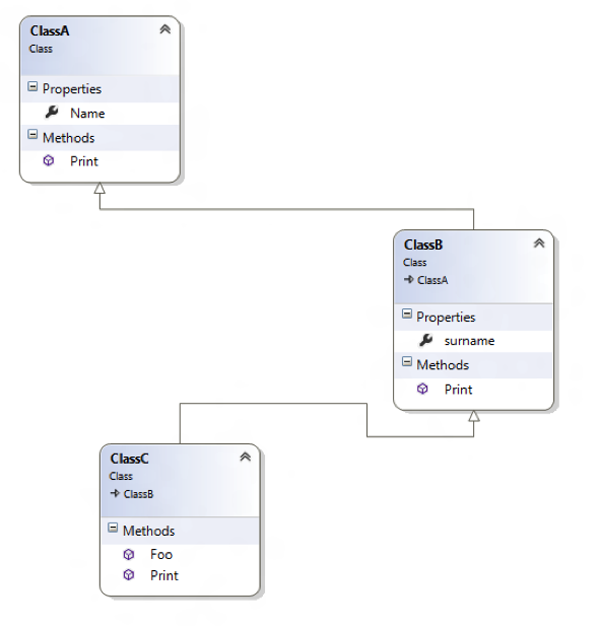A lot of my friends are
C# or C++ developers. They are used to using inheritance in their projects, and when they want to learn or discover JavaScript, one of the first
questions they ask is: “But how can I do inheritance with JavaScript?”
Actually, JavaScript uses a different approach than C# or C++ to create an object-oriented language. It is a prototype-based language. The concept of prototyping implies that behavior can be reused by cloning existing objects that serve as prototypes. Every object in JavaScript depends on a prototype which defines a set of functions and members that the object can use. There is no class—just objects. Every object can then be used as prototype for another object.
This concept is extremely flexible, and we can use it to simulate some concepts from OOP, like inheritance.
Implementing Inheritance
Let’s look at what we want to create with this hierarchy using JavaScript:

First of all, we can
create ClassA easily. Because there are no explicit classes, we can define a set
of behavior (A class so…) by just creating a function like this:
var ClassA = function() {
this.name = "class A";
}
This “class” can be
instantiated using the new keyword:
var a = new ClassA();
ClassA.prototype.print = function() {
console.log(this.name);
}
And to use it using our object:
a.print();
Fairly simple, right?
The complete sample is just eight lines long:
var ClassA = function() {
this.name = "class A";
}
ClassA.prototype.print = function() {
console.log(this.name);
}
var a = new ClassA();
a.print();
Now let’s add a tool to create “inheritance” between classes. This tool will just have to do one single thing: clone the prototype.
var inheritsFrom = function (child, parent) {
child.prototype = Object.create(parent.prototype);
};
This is exactly where the magic happens! By cloning the prototype, we transfer all members and functions to the new class.
So if we want to add a second class that will be child of the first one, we just have to use this code:
var ClassB = function() {
this.name = "class B";
this.surname = "I'm the child";
}
inheritsFrom(ClassB, ClassA);
Then because ClassB
inherited the print function from ClassA, the following code is
working:
var b = new ClassB(); b.print();
And produces the following output:
class B
We can even override the print
function for ClassB:
ClassB.prototype.print = function() {
ClassA.prototype.print.call(this);
console.log(this.surname);
}
In this case, the produced output will look like this:
class B I’m the child
The trick here is to call
ClassA.prototype to get the base print function. Then thanks to the call
function we can call the base function on the current object (this).
Creating ClassC is
now obvious:
var ClassC = function () {
this.name = "class C";
this.surname = "I'm the grandchild";
}
inheritsFrom(ClassC, ClassB);
ClassC.prototype.foo = function() {
// Do some funky stuff here...
}
ClassC.prototype.print = function () {
ClassB.prototype.print.call(this);
console.log("Sounds like this is working!");
}
var c = new ClassC();
c.print();
And the output is:
class C I’m the grandchild Sounds like this is working!
More Hands-On With JavaScript
It might surprise you a bit, but Microsoft has a bunch of free learning on many open source JavaScript topics, and we’re on a mission to create a lot more with Microsoft Edge. Check out my own:
- Introduction to WebGL 3D with HTML5 and Babylon.JS
- Building a Single Page Application with ASP.NET and AngularJS
- Cutting Edge Graphics in HTML
Or our team’s learning series:
- Practical Performance Tips to Make your HTML/JavaScript Faster (a seven-part series from responsive design to casual games to performance optimization)
- The Modern Web Platform Jump Start (the fundamentals of HTML, CSS, and JS)
- Developing Universal Windows App with HTML and JavaScript Jump Start (use the JS you’ve already created to build an app)
And some free tools: Visual Studio Community, Azure Trial, and cross-browser testing tools for Mac, Linux, or Windows.
And Some Philosophy…
To conclude, I just want to clearly state that JavaScript is not C# or C++. It has its own philosophy. If you are a C++ or C# developer and you really want to embrace the full power of JavaScript, the best tip I can give you is: Do not try to replicate your language into JavaScript. There is no best or worst language. Just different philosophies!
This article is part of the web dev tech series from Microsoft. We’re excited to share Microsoft Edge and the new EdgeHTML rendering engine with you. Get free virtual machines or test remotely on your Mac, iOS, Android, or Windows device @ http://dev.modern.ie/.


Comments